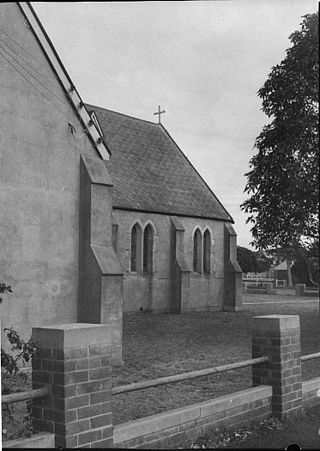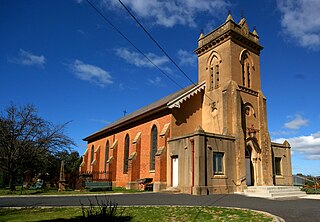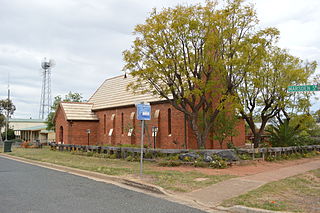
St Andrew's Cathedral is a cathedral church of the Anglican Diocese of Sydney in the Anglican Church of Australia. The cathedral is the seat of the Anglican Archbishop of Sydney and Metropolitan of New South Wales. The position of Dean of Sydney has been held by the Very Reverend Sandy Grant since 9 December 2021.
Marulan is a small town east of the Great Dividing Range and is located in the Southern Highlands of New South Wales, Australia. It is in the Goulburn Mulwaree Council local government area and the traditional lands of the Gundungurra people. It is located south-west of Sydney on the Hume Highway, although it bypasses the town proper. Marulan lies on the 150th meridian east. It has a railway station on the Main Southern railway line. Marulan was previously known as Mooroowoolen.
Edmund Thomas Blacket was an Australian architect, best known for his designs for the University of Sydney, St. Andrew's Cathedral, Sydney and St. Saviour's Cathedral, Goulburn.

Bungonia is a small town in the Southern Tablelands in New South Wales, Australia in Goulburn Mulwaree. At the 2016 census, Bungonia had a population of 367. The name of the town derives from an Aboriginal word meaning 'sandy creek'.

The St Saviour's Cathedral is the heritage-listed cathedral church of the Anglican Diocese of Canberra and Goulburn in Goulburn, Goulburn Mulwaree Council, New South Wales, Australia. The cathedral is dedicated to Jesus, in his title of Saviour. The current dean is the Very Reverend Phillip Saunders. It was added to the New South Wales State Heritage Register on 20 April 2009.

St Peter's Anglican Church is a heritage-listed Anglican church located at 187-209 Princes Highway, St Peters, in Sydney, New South Wales, Australia. It is one of the oldest churches in Sydney. Designed by Thomas Bird, the church is sometimes referred to as St Peter's Church, Cooks River, as it is located in the Anglican Parish of Cooks River, New South Wales. The church is listed on the NSW State Heritage Register and on the Register of the National Estate.

The St John's Anglican Church, formally the Church of St John the Evangelist, also called St John's Cooks Hill, is an Anglican church in Newcastle, New South Wales, Australia. It is the oldest remaining church building in Newcastle, completed in 1860. The building, the design of which is attributed to colonial architect Edmund Blacket, in the Old Colonial Grecian Revival style, is located close to the city centre at 1D Parry Street, Cooks Hill. It was added to the New South Wales State Heritage Register on 2 April 1999.

Holy Trinity Anglican Church is a heritage-listed Anglican church precinct, containing the church, rectory and adjacent cemetery, at 71-85 Gilmour Street, Kelso, Bathurst Region, New South Wales, Australia. The church was built from 1833 to 1878, with John Foster being responsible for the building of the original church. Edmund Blacket designed the rectory. The property is owned by Anglican Property Trust Diocese of Bathurst and Parish of Kelso, Anglican Diocese of Bathurst. It was added to the New South Wales State Heritage Register on 14 January 2011.

Old Marulan Town is a heritage-listed former townscape at Marulan, New South Wales, Australia. It is the site of the original Marulan township prior to the moving of the village in the 1860s in the wake of the Main Southern railway bypassing the original town. It is also known as Mooroowoolen. It was built from 1835 to 1867. It was added to the New South Wales State Heritage Register on 2 April 1999.

St Peter and Paul's Old Cathedral is a heritage-listed former Catholic cathedral and now parish church at 42 Verner Street, Goulburn, Goulburn Mulwaree Council, New South Wales, Australia. It was designed by Andrea Stombuco and Charles Spadacini and built from 1871 to 1890 by C. J. O'Brien and Wilkie Bros. It is also known as St. Peter and Paul's Former Cathedral and St Peter and Paul's Catholic Cathedral; Saints Peter and Paul's Catholic Cathedral. It was added to the New South Wales State Heritage Register on 20 April 2009.

St Mary's Anglican Church is a heritage-listed Anglican church and associated facilities located at 240 Birrell Street, Waverley, in the Waverley Municipality, Sydney, New South Wales, Australia. The church was designed by Edmund Blacket and built between 1863 and 1864. It is very well known and sought after as a place to be married and is popular for funerals. The building is also notable due its pipe organ, designed and built by August Gern. The property is used for ministry by the Anglican Parish of Bondi and Waverley, which is an amalgamation of two previous Parishes ; The first Rector of St Mary’s Waverley, Rev Stanley Mitchell, was a keen Evangelical and although he used traditional Anglican liturgy was “low church” like most of Sydney Diocese. However there has been a long history of more “High” Anglicanism and Anglo Catholic theological underpinnings. Since 2014, the church has returned to a strongly evangelical base while running a very strong traditional 1662 prayer book communion service every Sunday. It also has less traditional al services to accommodate more contemporary congregations.

The All Saints' Anglican Church is a heritage-listed Anglican church located at McDonnell Street, Condobolin in the Lachlan Shire local government area of New South Wales, Australia. The church was possibly designed by Edmund Blacket and was built from 1878 to 1879 by Mr Brinsmead. It is also known as All Saints Anglican Parish Church. The property is owned by the Anglican Diocese of Bathurst. It was added to the New South Wales State Heritage Register on 2 May 2008.

St James' Anglican Church is a heritage-listed Anglican church precinct at 19 Tank Street, Morpeth, City of Maitland, New South Wales, Australia. The original design was attributed to Edward Charles Close, with later additions by Edmund Blacket and John Horbury Hunt and built from 1837 to 1875 by Edward Charles Close and James Sherwood. The precinct also includes the St. James' rectory and parish hall. The property is vested in the trustees of church property for the Diocese of Newcastle. It was added to the New South Wales State Heritage Register on 27 January 2017.

St Peter's Anglican Church and Glebe Cemetery are a heritage-listed Anglican church and closed cemetery in East Maitland, New South Wales, Australia. The church is at 49 William Street while the cemetery is approximately 1.2 km (0.7 mi) away, approximately 400 m (1,312 ft) beyond the end of George St, also in East Maitland. The church was designed by Cyril and Arthur Blacket and built from 1884 to 1886. The cemetery is also known as Glebe Gully Burial Ground and Glebe Paddock. It was added to the New South Wales State Heritage Register on 31 August 2012.

Holy Trinity Anglican Church is a heritage-listed Anglican church at Argyle Street, Berrima, Wingecarribee Shire, New South Wales, Australia. It was designed by Edmund Blacket and built from 1849. The property is owned by the Anglican Church Property Trust. It was added to the New South Wales State Heritage Register on 2 April 1999.

Christ Church is a heritage-listed Anglican church located on Bong Bong Road, Bong Bong, in the Wingecarribee Shire local government area of New South Wales, Australia. It was built in 1845 at the behest of Charles Throsby, possibly by convict labour. The design of the church has been attributed to John Verge. The church site includes an associated cemetery. It was added to the New South Wales State Heritage Register on 7 April 2000.

St John the Evangelist Church is a heritage-listed former Aboriginal land, squatting run, and farm village and now dual-denomination Anglican and Presbyterian church located at Main Street, Wallerawang, City of Lithgow, New South Wales, Australia. It was designed by Edmund Blacket and Blacket and Sons, and built from 1880 to 1881 by George Donald. It is also known as St. John the Evangelist Church and Church of St. John the Evangelist. It was added to the New South Wales State Heritage Register on 10 September 2004.

St John's Anglican Church and Macquarie Schoolhouse is a heritage-listed Anglican church building and church hall located at 43-43a Macquarie Road, Wilberforce, City of Hawkesbury, New South Wales, Australia. The church was designed by Edmund Blacket and built from 1819 to 1859 by James Atkinson, senior; and the schoolhouse was built by John Brabyn. The church is also known as the St. John's (Blacket) Church, while the hall is also known as the Macquarie Schoolhouse/Chapel and the Wilberforce Schoolhouse. It was added to the New South Wales State Heritage Register on 20 August 2010.

St Peter's Anglican Church is a heritage-listed Anglican church and associated Sunday school, rectory, and cemetery at 384 Windsor Street, Richmond, City of Hawkesbury, New South Wales, Australia. It was designed by Francis Clarke and Edmund Blacket and built from 1836 to 1841 by James Atkinson (church). It is also known as St Peter's Anglican Church Group, St Peter's Church Group, Church, Rectory, Church Yard, Cemetery and Stables. It was added to the New South Wales State Heritage Register on 16 August 2019; and on the City of Hawkesbury local government heritage register, and listed on the New South Wales Heritage Database on 12 September 2012.

St Stephen's Presbyterian Church and Manse, also known as Queanbeyan Presbyterian Church, is a heritage-listed Presbyterian church and manse at 2 Morisset Street, Queanbeyan, Queanbeyan-Palerang Region, New South Wales, Australia. It was designed by Alberto Dias Soares (church) and James Barnet (manse) and built from 1872 to 1883 by Thomas Priest (stonemason), Thomas Jordan (carpenter), John Kealman (carpenter). The property is owned by Presbyterian Church of NSW Property Trust. It was added to the New South Wales State Heritage Register on 24 May 2019.



















